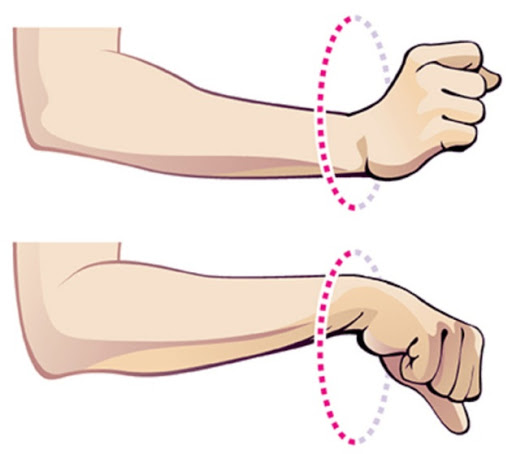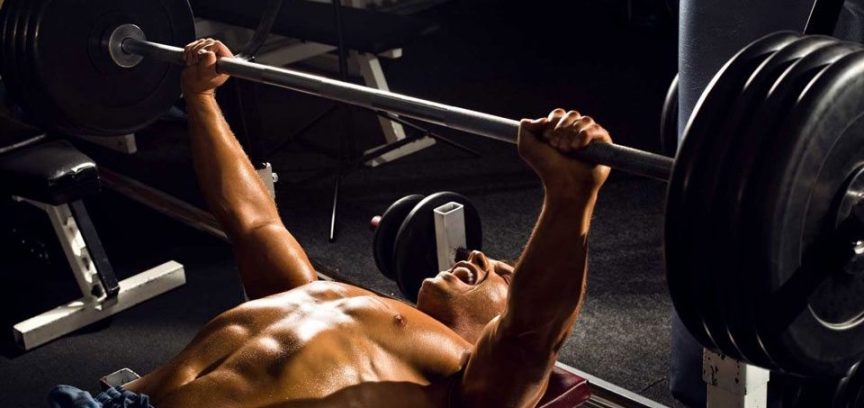The bench press is one of the most popular and widely performed chest exercises. It dates back to the year 1899, believe it or not! Today, the bench press is like the holy grail of weightlifting, and is seen in many weightlifting competitions. If you go to the gym, the majority of guys in the gym will be performing the bench press. The common question guys get asked is “how much can you bench bro?” So, who can blame guys for making bench press a priority. Not only that, but the chest is one of the main muscles you can see on yourself. So many guys want to target this muscle, and see the results. However, the bench press is not just for men. Many females perform the bench press and even compete in bench pressing competitions.
However, a common issue while bench pressing is wrist pain. Wrist pain is an extremely common issue among weightlifters. I often get asked about wrist pain during exercises such as bench press, shoulder press, push-ups, bicep curls, and even hand-stands. It is important to fix your wrist pain, because it can get worse if ignored. You do not want wrist pain hindering your gains, and hard work in the gym. This article is going to be discussing the reasons for your wrist hurting when bench pressing, and simple tips to fix this issue.
Anatomy Of The Wrist
First, I want to discuss the anatomy of the wrist. It is important to get a solid understanding of the anatomy when considering causes of pain. The wrist joint is a very unique joint that is made up of 8 small bones called carpal bones. These carpal bones are the reason we are able to move our wrist up and down, side to side, and in a circular motion. All these tiny carpal bones move along each-other to allow those motions.

Look at this image of the wrist. You can see the various tendons and ligaments within the wrist joint. These flexor tendons allow us to close our hand, and can give us a strong grip. Also, directly in the middle of the wrist runs the median nerve. The median nerve runs through the carpal tunnel, and can cause “carpal tunnel syndrome.” So, you can see just how many important bones, tendons, nerves, and ligaments are found within the wrist joint. So it is important to protect your wrist when bench pressing. You do not want to cause damage to any of these tendons or nerves.
Causes Of Wrist Pain When Bench Pressing
The most common cause of your wrist hurting when bench pressing is due to improper wrist positioning causing strain on the wrist joint. The wrists were not designed to lift heavy weights, especially with improper wrist positioning. Many people lift very heavy weight on the bench press, and never consider their wrist positioning. This is dangerous for the wrists, and can cause damage overtime. The wrist joint does not have much cartilage and protection, so it was not necessarily designed to tolerate heavy loads. This doesn’t mean you can’t bench press, but you need to take care of your wrist and fix your wrist form when bench pressing. It is extremely important to protect the wrists, especially if you want to remain lifting long-term.
Other less likely causes of your wrist hurting when bench pressing is due to wrist impingement, wrist tendonitis, carpal tunnel syndrome, or ligamentous sprain. However, in most cases it is simply inflamed due to improper wrist positioning when bench pressing. It is best to fix this issue now, before it progresses to a more serious issue like those listed above.
Fix Your Wrist Positioning When Bench Pressing
The first thing you need to do is fix your wrist positioning when bench pressing. This is extremely important, and can often fix the problem almost immediately. The problem is many people bench press with their wrists in extreme extension. Most people often don’t recognize this is happening, because they aren’t thinking about their wrist positioning. However, take a moment to think about what position your wrist are in when you bench press. I guarantee they are bent back in extension. Wrist extension is not necessarily a bad thing, but you do not want to have your wrist bent back under heavy loads like when bench pressing. When your wrist are in full extension the wrist joint is compressed, and can cause impingement of the tendons and ligaments within the wrist.

You want to maintain a strong neutral wrist position when bench pressing. Look at the image above. Most people bench press with their wrist extended like the image on the left. However, you want to keep a strong neutral grip like the image on the right. This will prevent strain on the wrist, and in most cases will eliminate wrist pain when bench pressing. It can be hard to maintain this wrist position, but you need to consciously think about your wrist positioning when bench pressing. You can train your mind and body to maintain proper wrist positioning when bench pressing. At first, you may feel weak or unstable in that position, but overtime you will strengthen your wrist in that neutral position.
Warm-Up Your Wrists Before Benching
Is is extremely important to warm-up before heavy lifting. I often see people who arrive to the gym, and immediately start lifting heavy-weight. This is one of the best ways to get injured. You need a proper warm-up before lifting weights, especially before bench pressing. You need to warm-up the entire upper-body, not just the wrists. However, it is important to warm-up the muscles of the shoulders, arms, forearms, and fingers. These muscles all play a role in a strong stable grip and wrist positioning when bench pressing. Wrists are often neglected during a warm-up, but you want to make sure to warm-up the wrists for bench pressing. It is simple to warm-up the wrists, and will only take a few minutes. I recommend at-least a quick 5-10 minute warm-up before bench pressing.

Quick 5 Minute Wrist Warm-Up:
- 1 Minute Wrist Circles– Simply roll your wrists clockwise and counterclockwise. This will help warm-up the forearm muscles and lubricate the wrist joint.
- 1 Minute Wrist Side to Side– Move your wrist back and fourth from side to side. This will help prepare the wrist joint for heavy loads when bench pressing.
- 1 Minute Wrist Up & Down– Move your wrist back and fourth from up and down. This is working both wrist flexion and extension.
- 1 Minute Finger Opening/Closing– Simply open and close your hands. This will help warm-up the wrist flexors and extensors.
- 1 Minute Wrist Curls– I recommend doing some wrist curls with light dumbbells. This will help prepare the wrist for the heavier loads when bench pressing.
Strengthen Your Wrists
It is important to maintain strong and healthy wrists when lifting weights. Many people often progress to heavier and heavier weights on the bench press, however their wrist strength is left behind. You can see why this would be an issue. You will only be as strong as your weakest link! So, it is extremely important to strengthen the wrists. The stronger your wrists are the more you will be able to tolerate lifting heavier weights while maintaining a strong neutral grip. Strong wrists will not only help with bench pressing, but it will help with grip strength, push-ups, bicep curls, hand-stands, and even punching power.
To strengthen your wrist you need to target both the wrist flexors and wrist extensors. These muscles are located in the forearm, and connect from your elbow down to your wrist. I highly recommend a wrist strengthening kit, because it will include various tools to target both the wrist flexors and wrist extensors. In most cases, people often have way stronger wrist flexors compared to wrist extensors. This is because we are gripping and grabbing various things throughout the day, so these muscles get strong. However, the muscles that open the hand or extend the wrist often get neglected. The best way to target the muscles that open the hand and muscles that extend the wrist is by using a set of finger bands. These finger bands simply slip onto your fingers and provide resistance when opening your hand. These are extremely beneficial for strong solid wrists. I recommend using these in the car or while at work, multiple times a week.
Try Dumbbell Bench Press
Another way to prevent your wrist from hurting when bench pressing is to switch to dumbbells. I have nothing against the standard barbell bench press, but if your wrists are bothering you while bench pressing, dumbbells can really help. I have seen people who have pain when bench pressing with a barbell, but feel much better when benching with dumbbells. This is because dumbbells allow for more range of motion of the wrists and hands.
When using a barbell the hands and wrists are stuck in one position, and must fixate to the bar. However, with dumbbells you are free to move your wrists up and down, side to side, and in a circular motion. This is extremely helpful, especially if you suffer from wrist pain while bench pressing. I recommend trying dumbbell bench press, at-least until your wrist pain goes away and you strengthen your wrists. Personally, I prefer using dumbbells anyways. I find it much easier to maintain proper wrist positioning with dumbbells.
Try Incline Bench Press
Another way to prevent your wrists from hurting when bench pressing is to switch to incline bench press. Changing the angle of the incline actually makes a huge difference with wrist positioning. Less load is directly transmitted down on the wrists due to the angle of the incline bench press. You no longer will be pushing straight up against gravity, but rather at an angle. However, you still need to maintain strong neutral wrist when gripping the bar or dumbbells.
I recommend trying a slight angle of 30-45 degrees when using the incline bench press. Make sure to adjust the seat position to an incline as well to prevent you from sliding down. You can vary the angles every time you do incline bench press to keep shocking the body, and target the chest muscles from multiple angles. This is a great way to build up the pectoral muscles, and prevent wrist pain while bench pressing.
Wear Wrist Wraps When Bench Pressing
Wrist wraps are a great way to help stabilize and support the wrists. I recommend using wrist wraps only for heavy loads on exercises like the bench press, shoulder press, push-ups, hand-stands, etc. However, they are great to use while your wrist is healing and recovering. It will take some time for the inflammation and pain to completely go away in your wrist, but it will get better if you follow the tips in this guide. In the mean time, wrist wraps are a good way to add extra support when bench pressing.
The main reasons wrist wraps work so well for bench pressing and shoulder pressing is because it maintains the wrists in a strong neutral alignment. Like I said earlier, the main cause of your wrist hurting from bench pressing is due to improper wrist positioning. This causes strain of the tendon and ligaments within the wrist joint. So, wrist wraps can help avoid this and fix poor wrist positioning. Listed above are my 3 favorite wrist wraps to use for exercises like the bench press.
Final Thoughts
I know wrist pain can be annoying especially when trying to workout, but remember to take your wrist pain seriously. You want to fix the issue before it gets worse. I recommend starting by fixing your wrist positioning during the bench press. In most cases, this will feel much better and can even eliminate your wrist pain when bench pressing. Also, you should incorporate some wrist strengthening exercises into your weekly routine. Using the finger bands won’t take much effort and time, but it will make a huge difference in your overall wrist strength. Make sure to warm-up prior to bench pressing! This will only take 5-10 minutes, and can help lubricate the wrists to prepare them for heavy loads. Use my quick 5 minute wrist warm-up that is listed above.
I know a lot of people who have purchased wrist wraps, and they seem to really help. I recommend only using them for certain exercises like benching, shoulder pressing, bicep curls, or hand-stands. You still want to maintain strong wrists naturally, so incorporate the wrist exercises into your routine. If the wrist pain does not get better after following this guide, then you may want to go get it checked by a medical professional. However, in most cases the pain will reside on its own after listening to the tips in this guide.







